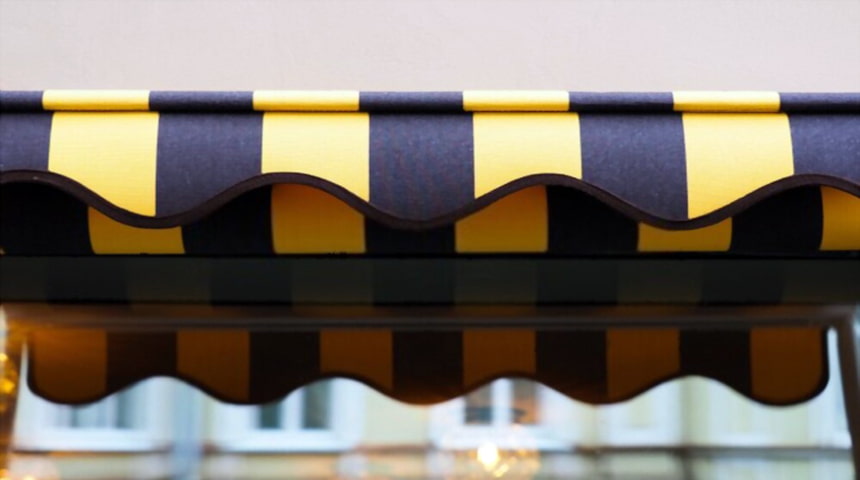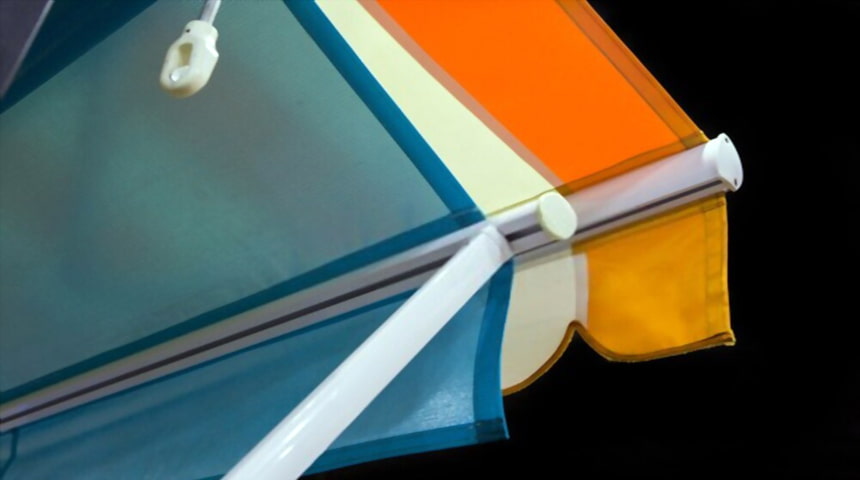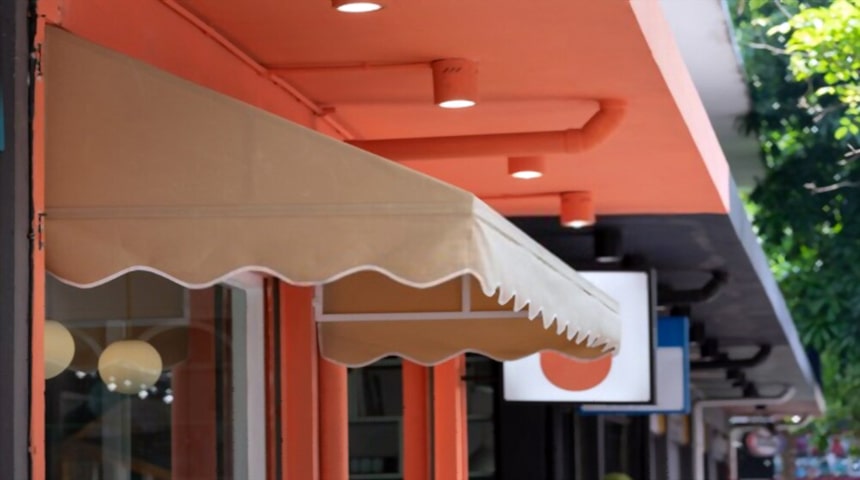Hinged arms visible when the decor awning is retracted or annoying glare when the sun is low in the sky? The decorative awning valances offer the solution for different aspects.
If a decorative awning with a valance is perceived at first glance as a decorative finish to the awning, it also has other useful properties that also increase outdoor comfort. The different shapes and designs of the valance ensure a perfect integration into the overall look of the awning.
Decorating awnings with fabrics and valances.
The decoration of awnings with fabrics and valances takes on a variety of tasks. While the focus is often on the decorative aspect, there are many other areas where awning decoration with fabrics can score points.
A valance is attached to the end of the front rail and is therefore visible at all times, even when retracted. It forms a visual finish, so that the hinged arms of the decorative awning are easily covered in non-open models.
Because the fabric or valance runs vertically downwards and is visible both when the awning fabric is extended and retracted, it is often used in the catering or retail sector for advertising purposes.
And it is printed with the company name or brand logo. But even in the private sector, a decorative valance awning can often be customised and labelled if desired.
In the case of open and half-open folding arm awnings, the valance also serves as a cover and protection. When the awning fabric is rolled up, it protects the construction of the awning types mentioned and thus contributes to the longevity of the sun protection element.

Awning decoration with additional sun and glare protection with steering wheel.
- sun protection
- privacy screen
- glare protection
A decorative awning valance also makes a further contribution to sun protection. This is particularly important when the sun shines into the terrace area from the front in the morning or evening or when the sun is particularly low at a certain time.
Thanks to the shading of the vertical awning, the textile border keeps glare at bay. As the valance is generally produced in individual dimensions, the additional shaded area varies.
The larger the decorative awning valance, the more glare, privacy and sun protection there is at the end.
In principle, however, it can be said that a standard decorative awning valance with a length of about 20 cm is sufficient to provide additional shade and protection from the sun’s annoying rays.
For this purpose, a wind sensor for awnings can always be installed, which will do the job for you when you are not present.
Decorative awning valance.
In order to create a harmonious overall picture at the end, you can often select different designs, shapes and colours for the pergola awning valance.
The possible shapes vary from straight to classic wavy, deep or strongly wavy to jagged. But a mixture of wavy and straight is also possible.
The classic valance shape is the wavy version. The straight valance shape is used especially in modern architecture, as it emphasises the clear lines of the construction.
Design and colour.
As well as the shape, colour and design of the terrace awning valance can also be individually combined. The design and colour of the decorative awning fabric are most often used to create a uniform look.
However, in many cases a mixture is also possible. This means that a striped awning fabric, for example, can be combined with a single-coloured valance.
As a rule, the same fabric types are used for valances as for decorative awning fabrics. Polyacrylic or polyester is usually used here.
Acrylic fabrics offer the advantage that they are yarn-dyed, which means that the colour pigments are embedded in the fibres during manufacture. Decorative awning fabrics and valances made of polyacrylic are particularly lightfast and colourfast. Nevertheless, awnings should be cleaned at least once a year.
Valance valance for awning decoration.
The valance is a special variant of the window awning valance. The big difference to standard valances is that the valance valance can be continuously extended and retracted. It is therefore a kind of second facade awning.
As the valance is integrated into the front profile, it disappears almost invisibly into an inconspicuous housing at the end of the front profile, so that a classic crank drive or an electric drive can be selected for operation.
Because the valance valance can be individually adjusted in contrast to standard valances, it offers flexible protection against sun and glare, depending on the position of the sun.
Shading with decorative awning valances.
However, it is not only the shaded area that is significantly increased when using a valance, the textile border can also increase the privacy of neighbouring properties.
Thanks to its extendable length, it offers effective privacy protection compared to conventional valances.
In addition to the conventional decorative awning fabric, there is often also a screen fabric to choose from for the valance fabric, as is also used for textile screens.
The special fabric allows a slight incidence of light during the day and a shady view of the outside from the inside, but keeps out prying eyes from the outside.
Advantages of the decorative awning.
- Continuously retractable and extendable;
- Disappears almost invisibly;
- Flexible protection against sun and glare;
- Effective privacy protection;
This is also the case with the extendable awning model with valance, where the valance, which is integrated flush into the front profile, is made in various lengths and, depending on your wishes and projection, with awning fabric or translucent screen fabric.

Decorative awning: With or without valance?
The choice of a decorative awning with or without valance depends on several factors and, of course, entirely on personal taste. Due to the construction of some models, no valance can be integrated.
With cassette awnings in particular, the casing itself protects the fabric and the awning mechanism and, when retracted, also ensures a closed appearance. In open or sail awning models, on the other hand, a valance can act as a cover and thus protect the construction.
The orientation of the awning determines the direction of the valance.
If the terrace or balcony faces east or west in such a way that low sun rays are often disturbing and dazzling, a valance can offer additional comfort and protection against glare.
In particular, valance valances for decorative awnings allow flexible vertical shading, as they can be extended and retracted in comparison to conventional valances.
This property is also an advantage in densely built-up areas, as thanks to their widely extendable length, they create a high degree of privacy and intimacy.
Proper cleaning and care of the decorative awning.
Just like the decorative awning fabric, the valance should be cleaned regularly. Dirt can be carefully cleaned off with water and a root brush. To further extend the longevity, it is advisable to remove a classic fabric valance from the front profile in the winter months and store it in a sheltered place.
A valance on the decorative awning offers many advantages such as protection from sun, glare and privacy for a long time.

